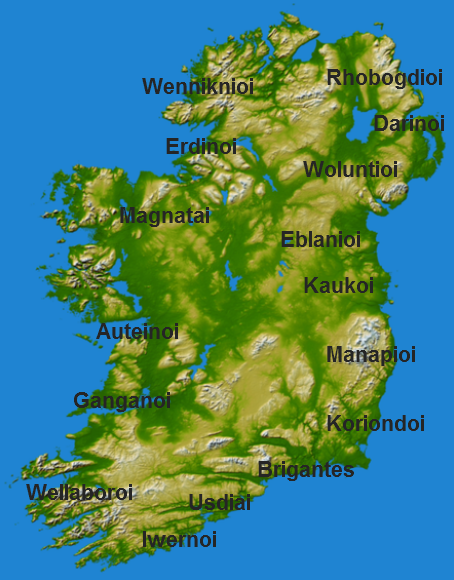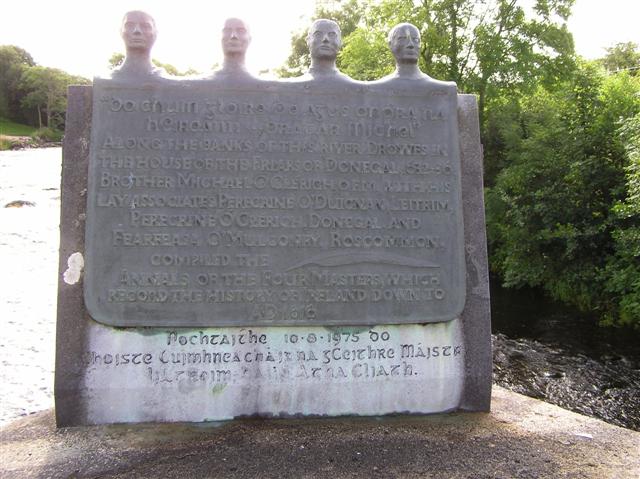|
Fíatach Finn
Fiatach Finn mac Dáire, a distant descendant of Óengus Tuirmech Temrach, was, according to medieval Irish legend and historical tradition, a king of the Ulaid, later a High King of Ireland, and the eponymous ancestor of the early Medieval Ulster dynasty of the Dál Fiatach. He was king of the Ulaid while Feradach Finnfechtnach was High King, and succeeded to the High Kingship himself when Feradach died. He ruled for three years until he was killed by Fíachu Finnolach. The ''Lebor Gabála Érenn'' synchronises his reign with that of the Roman emperor Nerva (AD 96–98). The chronology of Geoffrey Keating's ''Foras Feasa ar Éirinn'' dates his reign to AD 25–28, that of the ''Annals of the Four Masters'' to AD 36–39. Fiatach Finn mac Dáire was also a cousin of the legendary Cú Roí mac Dáire and Conaire Mór of the Érainn and Dáirine (Clanna Dedad). The Dál Fiatach are said to descend from the "Family of Cú Roí" in the Book of Glendalough (Rawlinson B 502). [...More Info...] [...Related Items...] OR: [Wikipedia] [Google] [Baidu] |
Geoffrey Keating
Geoffrey Keating ( ga, Seathrún Céitinn; c. 1569 – c. 1644) was a 17th-century historian. He was born in County Tipperary, Ireland, and is buried in Tubrid Graveyard in the parish of Ballylooby-Duhill. He became an Irish Catholic priest and a poet. Biography It was generally believed until recently that Keating had been born in Burgess, County Tipperary; indeed, a monument to Keating was raised beside the bridge at Burgess, in 1990; but Diarmuid Ó Murchadha writes, In November 1603, he was one of forty students who sailed for Bordeaux under the charge of the Rev. Diarmaid MacCarthy to begin their studies at the Irish College which had just been founded in that city by Cardinal François de Sourdis, Archbishop of Bordeaux. On his arrival in France he wrote ''Farewell to Ireland'', and upon hearing of the Flight of the Earls wrote ''Lament on the Sad State of Ireland''. After obtaining the degree of Doctor of Divinity at the University of Bordeaux he returned about 161 ... [...More Info...] [...Related Items...] OR: [Wikipedia] [Google] [Baidu] |
Darini
The Darini (Δαρῖνοι) (manuscript variant: Darnii �άρνιοι were a people of ancient Ireland mentioned in Ptolemy's 2nd century ''Geography'' as living in south Antrim and north Down. Their name implies descent from an ancestor called Dáire (''*Dārios''), T. F. O'Rahilly, ''Early Irish History and Mythology'', Dublin Institute for Advanced Studies, 1946, p. 2, 7 as claimed by several historical peoples, including the Dál Riata and Dál Fiatach (Ulaidh) in the same area of eastern Ulster as well the Érainn ( Iverni) of Munster. An early name for Dundrum, County Down, is recorded as ''Dún Droma Dáirine'', and the name Dáirine was applied to the Érainn dynasty. Overview The cognate ''Dari(o)'' ("agitation, tumult, rage") is a form widely attested in the Gaulish language, especially in personal names, and exists in the Welsh language as ''cynddaredd'' ("rage"). Thus the Darini may have been considered a people "of great violence" and descendants of a so called " ... [...More Info...] [...Related Items...] OR: [Wikipedia] [Google] [Baidu] |
Kings Of Ulster
The King of Ulster (Old Irish: ''Rí Ulad'', Modern Irish: ''Rí Uladh'') also known as the King of Ulaid and King of the Ulaid, was any of the kings of the Irish provincial over-kingdom of Ulaid. The title rí in Chóicid, which means "king of the Fifth", was also sometimes used. Originally referring to the rulers of the Ulaid of legend and the vastly reduced territory of the historical Ulaid, the title ''rí Ulad'' ceased to exist after the Norman invasion of Ulaid in 1177 and the subsequent foundation of the Earldom of Ulster. The Mac Dúinnshléibe dynasty of Ulaid (English: Donleavy / Dunleavy) were given the title of ''rex Hibernicorum Ulidiae'', meaning "king of the Irish of Ulaid", until the extinction of their dynasty by the end of the 13th century. After the earldom's collapse in 1333, the title was resurrected and usurped after 1364 by the Ulaid's chief Gaelic rivals the Northern Uí Néill, who had overrun the ruins of the earldom and established the renamed tuath ... [...More Info...] [...Related Items...] OR: [Wikipedia] [Google] [Baidu] |
List Of High Kings Of Ireland
Medieval Irish historical tradition held that Ireland had a High King (''Ard Rí'') based at Tara since ancient times, and compilations like the 11th-century '' Lebor Gabála Érenn'', followed by Early Modern works like the ''Annals of the Four Masters'' and '' Foras Feasa ar Éirinn'', purported to trace the line of High Kings. John T. Koch explains: "Although the kingship of Tara was a special kingship whose occupants had aspirations towards supremacy among the kings of Ireland, in political terms it is unlikely that any king had sufficient authority to dominate the whole island before the 9th century". Máel Sechnaill I is often considered the first historical High King, although he faced some opposition. Applying the title to earlier kings is considered anachronistic, while kings from before the 5th century are generally considered legendary. The traditional list of High Kings is thus a mixture of historical facts and legend. The annals describe some later High Kings ... [...More Info...] [...Related Items...] OR: [Wikipedia] [Google] [Baidu] |
Book Of Glendalough
Oxford, Bodleian Library, Rawlinson B 502 is a medieval Irish manuscript which presently resides in the Bodleian Library, Oxford. It ranks as one of the three major surviving Irish manuscripts to have been produced in pre-Norman Ireland, the two other works being the Lebor na hUidre and the Book of Leinster. Some scholars have also called it the Book of Glendalough, in Irish ''Lebar Glinne Dá Locha'', after several allusions in medieval and early modern sources to a manuscript of that name. However, there is currently no agreement as to whether Rawlinson B 502, more precisely its second part, is to be identified as the manuscript referred to by that title. It was described by Brian Ó Cuív as one of the "most important and most beautiful ... undoubtedly the most magnificent" of the surviving medieval Irish manuscripts. Pádraig Ó Riain states ".. a rich, as yet largely unworked, source of information on the concerns of the community at Glendalough in or about the year 1131, ... [...More Info...] [...Related Items...] OR: [Wikipedia] [Google] [Baidu] |
Dáirine
The Dáirine (Dárine, Dáirfine, Dáirfhine, Dárfine, Dárinne, Dairinne), later known dynastically as the Corcu Loígde and associated, were the proto-historical rulers of Munster before the rise of the Eóganachta in the 7th century AD. They were derived from or closely associated with the Darini of Ptolemy and were also related to the Ulaid and Dál Riata of Ulster and Scotland.O'Rahilly 1946 Their ancestors appear frequently in the Ulster Cycle. In historical times the Dáirine were represented, as stated, by the Corcu Loígde, the Uí Fidgenti and Uí Liatháin, as well as a few other early historical kindreds of both Munster and Ulster. In ancient genealogical schemes, the historical Dál Fiatach of Ulaid also belong to the Dáirine. History Dáirine can sometimes refer to the Érainn dynasties as a whole instead of the distinct royal septs mentioned above. The Dáirine of Munster were said to descend from a certain Dáire (''*Dārios''), both Dáire Doimthech (Sírchr ... [...More Info...] [...Related Items...] OR: [Wikipedia] [Google] [Baidu] |
Érainn
The Iverni (, ') were a people of early Ireland first mentioned in Ptolemy's 2nd century ''Geography'' as living in the extreme south-west of the island. He also locates a "city" called Ivernis (, ') in their territory, and observes that this settlement has the same name as the island as a whole, Ivernia (, '). It was probably once the name given to all the peoples of Ireland, but by Ptolemy's time had a more restricted usage applicable to the inhabitants of the south-west. These Iverni can be identified linguistically with the Érainn (Éraind, Érnai, Érna), a people attested in Munster and elsewhere in the early Middle Ages. The prehistoric Érainn royal dynasties are sometimes referred to as the Dáirine. Etymology The name Iverni has been derived from Archaic Irish ''*Īwernī'' meaning "folk of ''*Īweriū'' " (the island of Ireland). This is in turn derived from Proto-Celtic *''Φīwerjon-'' and further from Proto-Indo-European *''piHwerjon-'' (the fertile land), whi ... [...More Info...] [...Related Items...] OR: [Wikipedia] [Google] [Baidu] |
Conaire Mór
Conaire Mór (the great), son of Eterscél, was, according to medieval Irish legend and historical tradition, a High King of Ireland. His mother was Mess Búachalla, who was either the daughter of Eochu Feidlech and Étaín, or of Eochu Airem and his daughter by Étaín. In the Old Irish saga ''Togail Bruidne Dá Derga'' he is conceived when his mother is visited by an unknown man who flies in her skylight in the form of a bird, and is brought up as Eterscél's son. History According to the '' Lebor Gabála Érenn'', he took power after killing his predecessor, and his father's killer, Nuadu Necht. In ''Togail Bruidne Dá Derga'' he succeeds Eterscél directly. When Eterscél dies, a bull-feast is held. A bull is killed, a man eats his fill of its meat and drinks its broth, and sleeps as incantations are chanted over him. Whoever this man sees in his sleep will be the new king. He sees a naked man coming along the road to Tara with a stone in his sling. The young Conaire, me ... [...More Info...] [...Related Items...] OR: [Wikipedia] [Google] [Baidu] |
Annals Of The Four Masters
The ''Annals of the Kingdom of Ireland'' ( ga, Annála Ríoghachta Éireann) or the ''Annals of the Four Masters'' (''Annála na gCeithre Máistrí'') are chronicles of medieval In the history of Europe, the Middle Ages or medieval period lasted approximately from the late 5th to the late 15th centuries, similar to the post-classical period of global history. It began with the fall of the Western Roman Empire a ... Irish history. The entries span from the Flood myth, Deluge, dated as 2,242 Anno Mundi, years after creation to AD 1616. Publication delay Due to the criticisms by 17th century Irish historian Tuileagna Ó Maol Chonaire, the text was not published in the lifetimes of any of the participants. Text The annals are mainly a compilation of earlier annals, although there is some original work. They were compiled between 1632 and 1636, allegedly in a cottage beside the ruins of Donegal Abbey, just outside Donegal (town), Donegal Town. At this time, howeve ... [...More Info...] [...Related Items...] OR: [Wikipedia] [Google] [Baidu] |
Nerva
Nerva (; originally Marcus Cocceius Nerva; 8 November 30 – 27 January 98) was Roman emperor from 96 to 98. Nerva became emperor when aged almost 66, after a lifetime of imperial service under Nero and the succeeding rulers of the Flavian dynasty. Under Nero, he was a member of the imperial entourage and played a vital part in exposing the Pisonian conspiracy of 65. Later, as a loyalist to the Flavians, he attained consulships in 71 and 90 during the reigns of Vespasian and Domitian, respectively. On 18 September 96, Domitian was assassinated in a palace conspiracy involving members of the Praetorian Guard and several of his freedmen. On the same day, Nerva was declared emperor by the Roman Senate. As the new ruler of the Roman Empire, he vowed to restore liberties which had been curtailed during the autocratic government of Domitian. Nerva's brief reign was marred by financial difficulties and his inability to assert his authority over the Roman army. A revolt by th ... [...More Info...] [...Related Items...] OR: [Wikipedia] [Google] [Baidu] |



